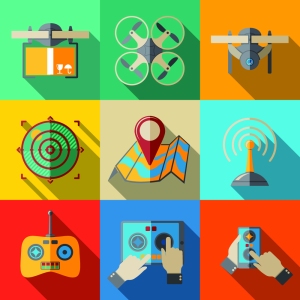Monika Coflin
Technical Assistant
Division of Security Policy
Drones, or unmanned aerial vehicles, have been in the news lately. Last fall, unidentified drones breached restricted airspace over 13 of France’s 19 nuclear power plants in a seemingly coordinated fashion. In January, a drone crashed onto the lawn of the White House. And this week, a drone was found on the roof of the Japanese prime minister’s office.
 Drones may be fun toys, but they pose a number of concerns. They can be used to conduct surveillance to gather intelligence about facility security. They can also be used to deliver payloads that could include explosives. While the majority of drones currently in use are relatively small, larger ones are becoming available that could possibly deliver payloads capable of causing damage to facilities that are not hardened.
Drones may be fun toys, but they pose a number of concerns. They can be used to conduct surveillance to gather intelligence about facility security. They can also be used to deliver payloads that could include explosives. While the majority of drones currently in use are relatively small, larger ones are becoming available that could possibly deliver payloads capable of causing damage to facilities that are not hardened.
Security experts haven’t yet identified who was responsible for the French flyovers, but with the prices of drones falling and their popularity rising, the potential threat will likely continue to grow.
There are ways to detect and intercept drones, such as jamming radio signals or using helicopters to pursue encroaching drones. Chinese scientists are developing a laser weapon that can detect and shoot down small, low-flying aircraft, and interception drones have the ability to drop nets over intruding drones. However, there are many legal issues that challenge the use of these techniques.
The Federal Aviation Administration (FAA) has a long-standing “Notice to Airmen” warning pilots not to linger over nuclear power plants. The FAA has also issued guidelines on where users should not fly drones, but the industry is largely unregulated as more companies look to use the relatively new technology in their businesses. The FAA has been working to craft a comprehensive regulatory framework for drones, following calls from Congress and the President, and recently issued draft regulations for the commercial use of drones.
 President Obama likened the drone industry to cyberspace, which has brought new technologies that U.S. laws are still trying to catch up to.
President Obama likened the drone industry to cyberspace, which has brought new technologies that U.S. laws are still trying to catch up to.
“These technologies that we’re developing have the capacity to empower individuals in ways that we couldn’t even imagine 10-15 years ago,” the President said, pledging to work to create a framework that “ensures that we get the good and minimize the bad.”
Given the evolving nature of technology and the need to balance the threat with the potential benefits of drones, the NRC is actively engaging with the departments of Homeland Security, Energy, and Defense to move this government collaboration effort forward. For example, we have reached out to the FAA to examine available legal and regulatory options, and attended inter-agency meetings to learn about how other agencies are addressing potential impacts from drones.
In addition, NRC will participate in a U.S.-initiated drone working group under the nuclear counterterrorism umbrella with the governments of France and the United Kingdom. The NRC has provided, and will continue to provide, pertinent information on this topic in a timely manner to its licensees to ensure continued safe and secure operations.

Hi admin, Thanks for sharing this article.
At the end of the day Drones are just tools. It’s too bad people want to explore the negative and overlook the amazing technology. We need to start seeing stories about how drones are saving lives and being used in search and rescue. Or to preforming dangerous tasks that normally cost human lives every year. Like any new technology it takes time for people to understand and accept it.
Once again thanks for sharing this incredible article.
Now a Days the drones have been a major factor.
The main thing we need in this matter is political/industry subterfuge. Drones are not the problem, the problem here is a failure to reinforce nuclear facility structures and proper Defense in Depth procedures to protect public safety.
Valuable information provided. Thanks
Nice information in the post thanks for sharing
Totally agree with your view. I read the blog and found that it will not be a good option to hover your drones over the government or sensitive locations (like nuclear plants). Using drones for commercial or personal purpose is a different thing, but using it for surveillance purpose is totally invalid.
When we talk about the future of drones, it can be proved beneficial in photography, security, disaster management, product delivery system, etc. But hovering over sensitive locations is not legal and not allowed by the FAA. Because of this, the FAA used to make amendments to its drone flying guidelines.
While I don’t think drones belong flying over government facilities, such as nuclear power plants, I think they are useful in a photography / videography sense, not to mention search and rescue efforts or other dangerous activities where an eye in the sky is extra valuable.
Moderator: Verbiage removed to adhere to the Blog Comment Guidelines
Drones as nano-bots and nano-swarms…
Future Strategic Issues/Future Warfare [Circa 2025]
NASA Dennis Bushnell, Chief Scientist Langley
https://www.metabunk.org/attachments/future-strategic-issues-and-warfare-pdf.3295/
Transoceanic UAV’s
• Current Capability – (‘98 – 29 lbs, 2000 mi., 1.5 gals. Fuel; ‘01 – Transpac, 5000 mi.
• Provides Capability for Undetectable Ultra-inexpensive Swarms Against CONUS
• Interesting (Precision) “Payloads”
– ISR
– Smart Dust/Explosive
– Target/explode Hazmat Trucks, Chem. Plants, Oil Storage/Refineries, etc.
– Bio Dispensers (Anti-People, Things, Plants)
– IW/EMP
– Brilliant/Miniature sensor/Mine Combos
– CNT’s (Power Lines, “Wire Blade”)
Summary – Major Influences of IT/Bio/Nano Upon Future Warfare
• Ubiquitous miniaturized/networked multi physics,hyperspectral sensors
• Robotics/Automatics “in the large”
• Long range precision strike/targeting
• Info/net Warfare
• Mini/micro/nano Sats, Cruise, UAV’s
• Binary Bio Weaponry
• Miniature/ubiquitous “smart mines”
At the end of the day Drones are just tools. It’s too bad people want to explore the negative and overlook the amazing technology. We need to start seeing stories about how drones are saving lives and being used in search and rescue. Or to preforming dangerous tasks that normally cost human lives every year. Like any new technology it takes time for people to understand and accept it.
True fascinating facts
Every new invention delivers new possibilities. There will be always some bad guys with the strong need to use new technology in a bad way. And in most cases they are out od control. What shall we do? Get used to it
Speaking of “droning on”…….
Garry Morgan – I agree with you, drones are not the real issue, all reactors need to be hardened in such a way as to make them safe from any attack short of War but as we now know the Nuclear Industry will not support doing that since it will make using Nuclear even less competitive with using Solar (of all flavors). So what we are left with is just more regulatory “sleight of hand” that is somehow supposed to solve a problem.
Of course – regulate drone operators – who will regulate the NRC’s failure to enforce law and policy relating to not enforcing Fire Regulations, Aging Management, or nuclear security, certainly not Congress?
Thus far, drone incursions are a demonstration of the failure of Nuclear Security and Human Reliability on the part of nuclear operators. Plus a blatant failure of any nuclear regulator, in this nation or other nations, to implement effective preventive measures for the protection of human life relating to aerial incursions to susceptible nuclear facilities
Drones are a tool, a tool and technology which have tremendous potential in radiological and security monitoring applications, particularly at nuclear facilities.
If I have a drone, and fly it outside any restricted airspace for the purpose of radiological monitoring, will I be regulated, arrested or harassed? Regulation is not an answer to all problems, particularly when the regulator fails to enforce the regulations or be proactive in preventing problems.
Action which secures nuclear facilities from overhead aerial attack is a solution. Unfortunately, as has been previously discussed at many NRC meetings and this blog site, spending money to protect the public from either negligent nuclear operators or terrorists is not a high priority on the part of nuclear facility owners or the NRC. The NRC has not yet required reinforcement of sheet metal structures of GE Mark 1 Reactors. Reinforcement of defective designs would solve many potential problems
By the way, the NRC’s failure to require overhead reinforcement of GE MARK 1 Nuclear Reactors is negligent on the part of the NRC. Regulation will not stop a terrorist intent on destroying a nuclear reactor. Actions which harden defective nuclear facility designs will stop an intrusion.
The last thing we need in this matter is political/industry subterfuge. Drones are not the problem, the problem here is a failure to reinforce nuclear facility structures and proper Defense in Depth procedures to protect public safety.
With Our Drone Achmed is Never Alone
Like nuclear power itself, drones are yet another “gift” wrought by technology that can be very dangerous. This is a very timely blog NRC. Agree that drone operators need to be regulated. However, as we know with gun control, the bad folks don’t follow the laws. Reports have it that ISIS elements are already in Mexico near our border. I hope the day never comes when we have to use drones to attack insurgents in our own country like we have been using drones to attack the bad guys overseas for some time. Can you imagine the threat not only from terrorists in our country but from the threat to our privacy, personal security, and even our liberties?!